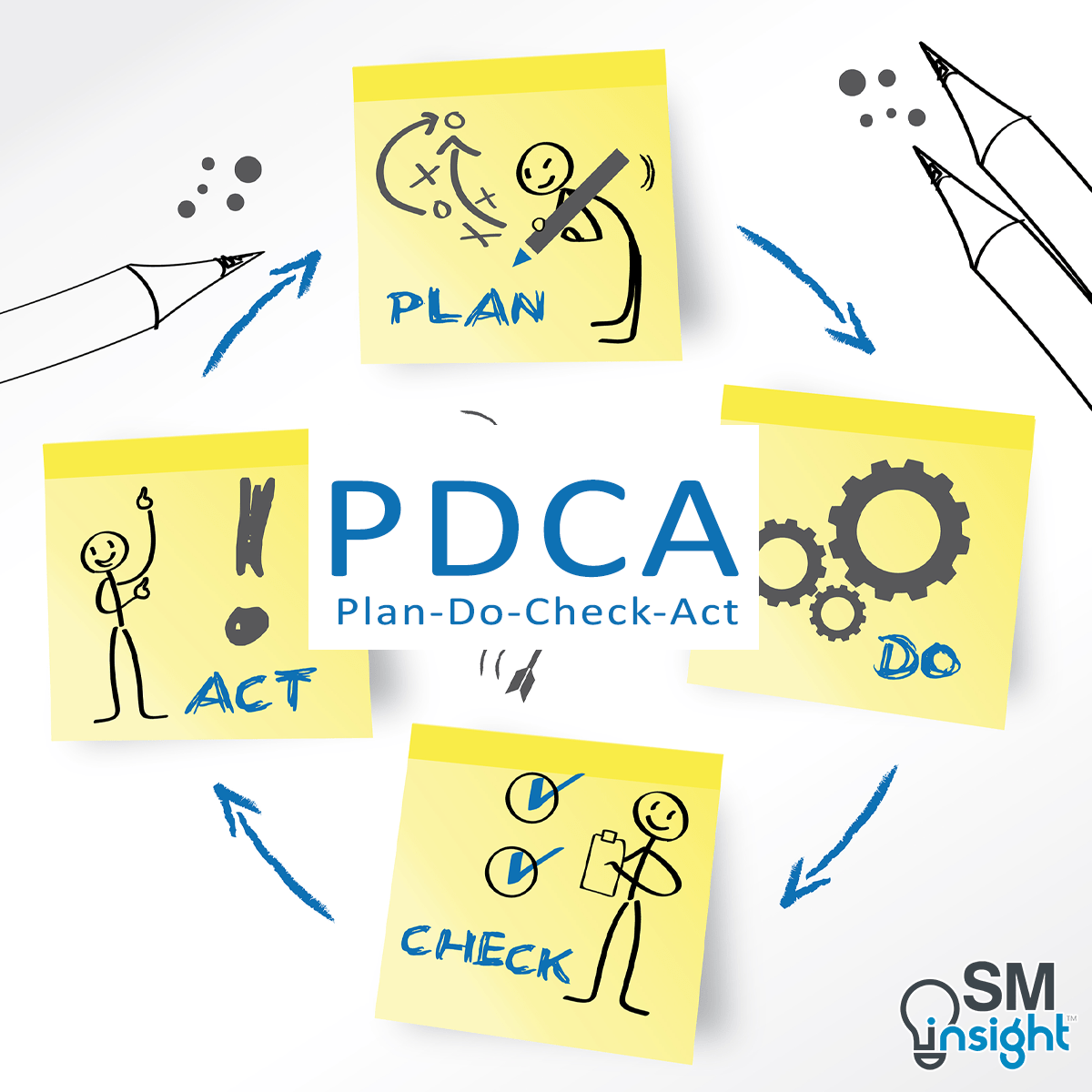What is the PDCA (Plan-Do-Check-Act) Cycle
Plan-Do-Check-Act Cycle (PDCA) is a four-step, iterative by-design method used for control and continual improvement of processes and products. It is also known as the Plan-Do-Study-Act (PDSA) cycle, Deming cycle, Control Circle/Cycle or the Shewhart cycle.
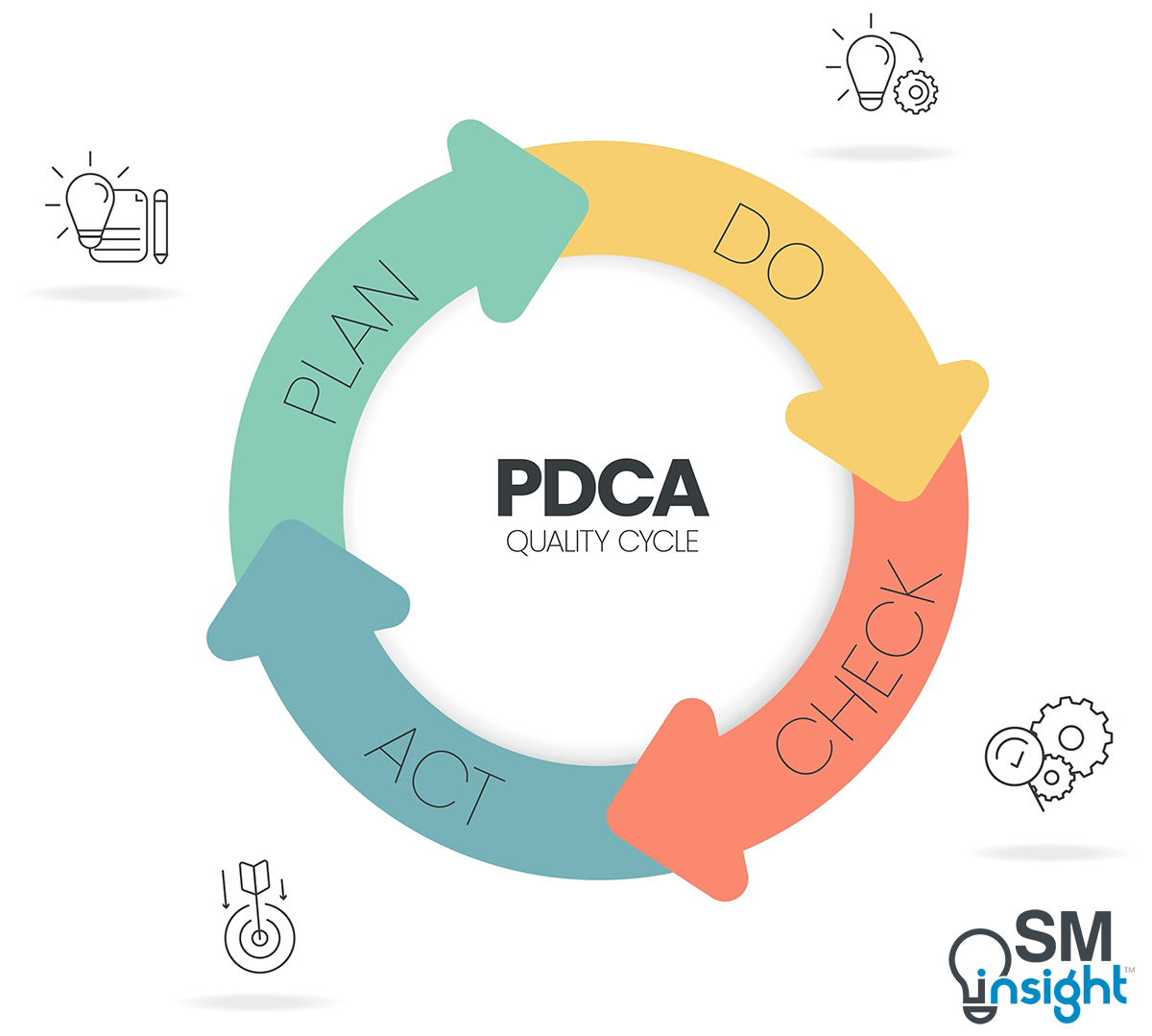
PDCA is an evidence-based participatory approach to problem-solving and is found to be an effective tool for quality improvement.
Origin of PDCA
The beginnings of PDCA emerged from the principles of the ‘Scientific Method’, which originated with Galileo but has its roots in the teachings of Aristotle. It is a method for developing ideas based on observation, then testing them through experiments and finally refining, changing, or eliminating the ideas.[2]
Dr. Walter Shewhart first adapted the scientific method for industry and presented it as a linear flow of ‘specification’, ‘production’ and ‘inspection’. In 1939, he changed the linear sequence to a cycle to show how refinement and change lead to an iterative approach to product development.
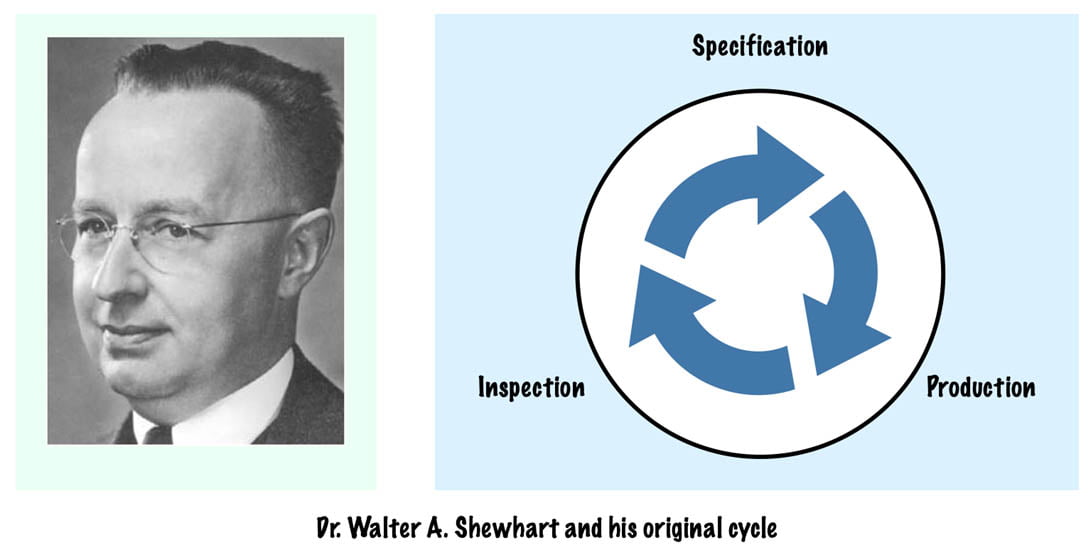
The Shewhart cycle was further developed by W. Edwards Deming in what became known as the ‘Deming Wheel’.

In 1950, Deming presented his ideas to the Japanese Union of Scientists and Engineers (JUSE) which then was popularized as the Plan, Do, Check, Act cycle or PDCA.[2]
Why use PDCA
Organizations often plan and then intend to execute, but the reality is neither linear nor predictable for this approach to be effective in reaching the target conditions.
Regardless of how well a plan is made, they must navigate a zone of uncertainty commonly referred to as the “Grey Zone.” Unforeseen problems, abnormalities, false assumptions, and obstacles will appear along the path to any target.

A good analogy is a person climbing stairs in the dark with a flashlight. Because the target condition lies beyond the reach of the flashlight, the path to attaining it cannot be predicted with exactness. Thus, the person must find that path by experimenting.
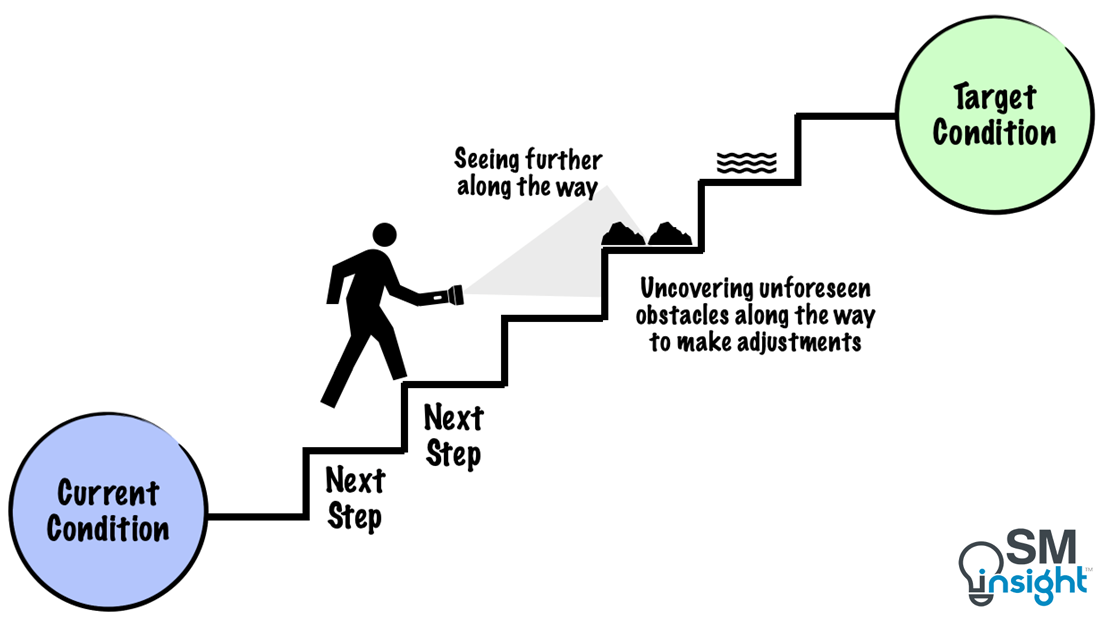
This is the central approach of PDCA. To expect uncertainty and pay attention to adjust along the way based on learnings. PDCA provides a practical means of attaining a challenging target condition by formulating hypotheses and testing them with information obtained from direct observation.
The Plan-Do-Check-Act (PDCA) cycle
The procedure or steps of experimentation in the PDCA cycle are summarized as below:
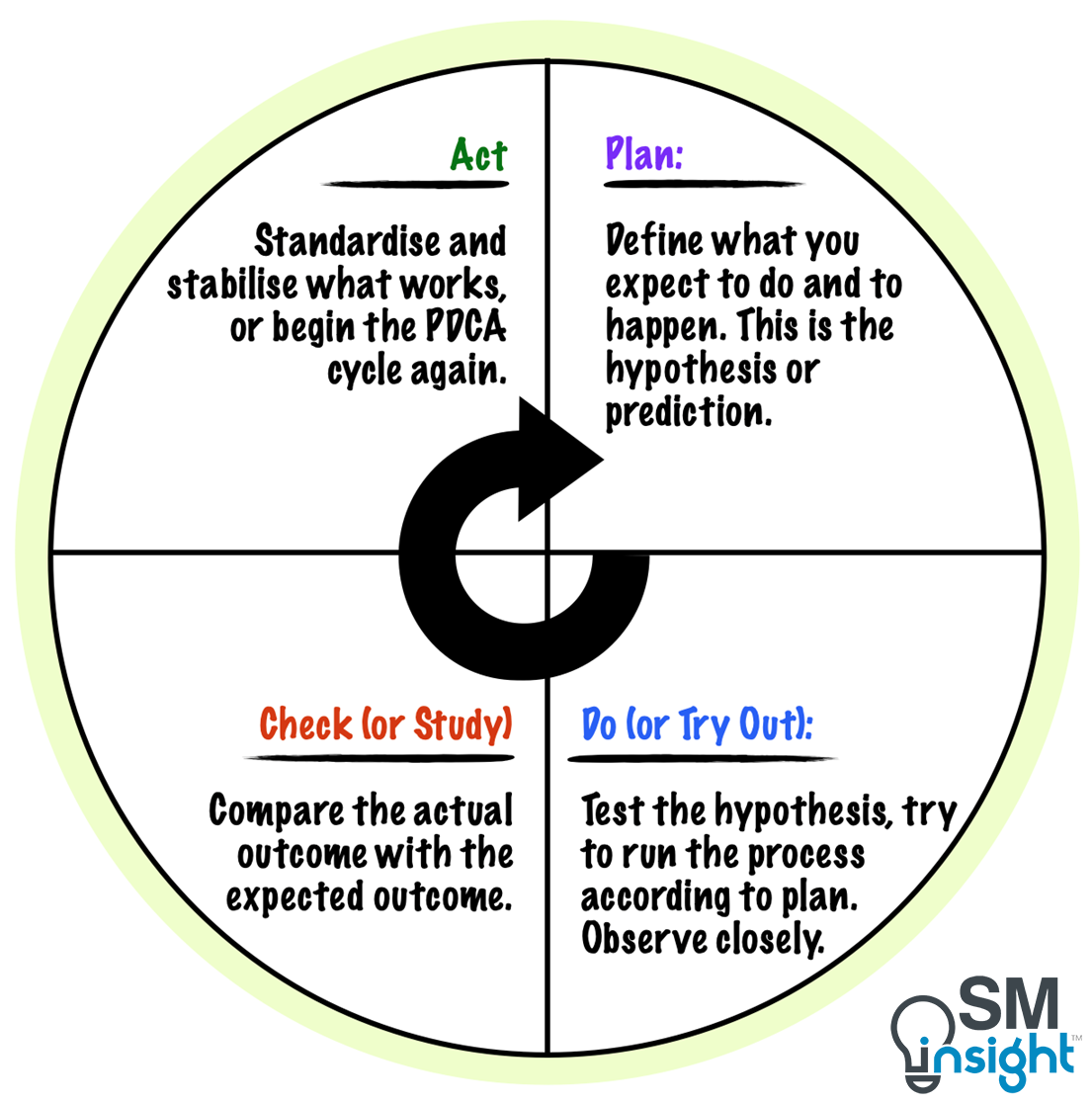
The four stages of PDCA
PDCA’s four stages constitute a scientific process of acquiring knowledge and are explained in more detail as follows:
P is for Plan
In the Planning stage, problems are identified and analyzed according to the following order:
- Select and prioritize the problems to be analyzed
- Clearly define the problem and establish a precise problem statement
- Perform situation analysis (to be used as baseline data)
- Set a measurable goal
- Perform root cause analysis (identify potential causes of problems)
- Identify intervention(s) that will address the root causes of problems
- Select an intervention and develop an action plan
D is for Do
At this stage, the team implements an action plan developed in the previous stage to make the desired changes. This involves the following steps:
- Execute the action plan on a trial or pilot basis
- Practice the proposed method(s)
- Make the changes
- Don’t strive for perfection but look for what can be done in a practical way
C is for Check
At this stage, data is collected once again to measure if the actions taken have improved the situation. It involves the following steps:
- Check whether the standard is being followed
- Measure the indicator and compare it with the baseline. Record the results
- Check what is working and what is not
- Identify systematic changes
- Practice and improve the activities as per the defined method
A is for Act
In the Act phase, interventions that are found to be effective are standardized by developing Standard Operating Procedures (SOPs), which involve the following steps:
- Continue activities that went as planned and were found effective
- Review (why) activities that did not perform well and propose changes
- Adopt the intervention(s)/ solution(s) as standard (standardize)
- Plan ongoing monitoring of the intervention(s)/ solution(s)
- Continue to look for incremental improvements and refine intervention(s)/ solution(s)
- Look for the next improvement opportunity
At the end of the fourth stage, the PDCA cycle restarts with the aim to solve another problem (or further improve the same problem) to achieve a continuous and uninterrupted improvement.
Seven steps in the PDCA cycle
PDCA cycle consists of seven steps spread over four stages, as shown:
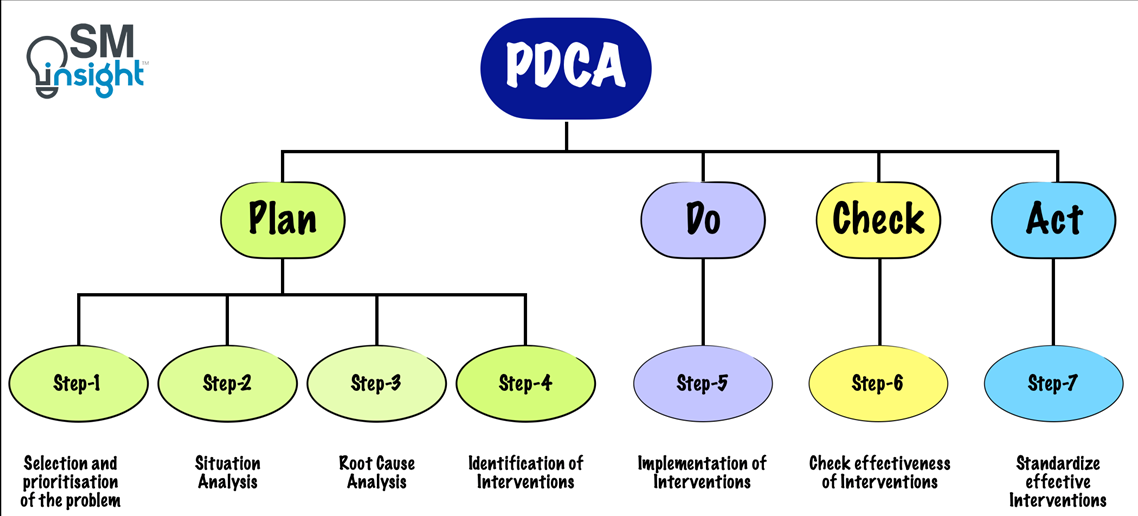
Step 1: Selection and problem prioritization
A problem is a brief description/statement of the weakness in the process or an issue to be solved. The tool most often used in this step is a Flowchart[6]. Alternatively, if a single problem is to be selected from a set of problems, a Selection Matrix[7] or a Fish Bone Diagram[8] may be used.
Selecting a problem is an iterative process where subsequent steps could lead to further refinement of the definition. A good problem should:
- Be customer‑focused.
- Complement the company’s and division’s goals.
- Address a weakness
- Be measurable
- Have a high probability of success within a reasonable time frame (3‑4 months)
- Be well-framed in one complete sentence
- Avoid the use of abstract words, acronyms, and location‑specific lingo
- Be action‑oriented
- Avoid the use of absolutes
- Address one of the 5 evils (defects, delays, mistakes, waste, accidents).
- Avoid stating the cause in the problem definition. (This is jumping to Step 3.)
- Avoid stating the solution in the problem definition. (This is jumping to Step 4.)
Problems can be prioritized based on:
- Their impact on the business
- Whether there are enough resources available to address them
- The ease of observing changes
- The extent to which team members have control
Step 2: Situation analysis
In this step, the focus is on gathering facts about the problem. The tool most often used at this point are Checksheets[9] and Pareto Charts[10]. Following are some of the key aspects of situation analysis:
- Before collecting data, all possible causes must be brainstormed.
- Ask 4W and 1H when collecting data: – Who is involved? – What problem/type of problem occurs? – When does it occur? – Which part of the process/type of product does it involve? – How much/many products/defects/etc. are involved?
- Limit data collection to what is needed. (Often, a sample will be sufficient.)
- Stratify (group) the data in many forms[11].
- Zero down on a few probable causes using a Pareto chart.
Step 3: Root cause analysis
A root cause is the fundamental reason behind negative process outcomes. A fishbone diagram[8] is the primary tool for root cause analysis. The root cause must be controllable and is found using the following approach:
- Answer the question, “Why did this ‘problem’ occur?”
- Brainstorm around: – Contributing factors. – The root cause of the contributing factors.
- Follow a fact-based approach. Assuming to know the cause can be counterproductive.
- Interview people who know the process.
- Construct/refer to a Flowchart of the process.
- Construct a Cause/Effect Diagram.
- Recycle back to Step 2 if required.
Step 4: Identification of intervention
This step brings ideas together to address a problem’s root cause. It is important to be open to options and think creatively. Affected individuals must be involved, and preference must be given to improving existing processes before revamping them entirely. Experiments are run to test solutions.
The proposed intervention must:
- Prevent the reoccurrence of the root cause.
- Be practical to implement, efficient and affordable.
- Be free from conflict with other processes or activities.
- Address the 4W’s and 1H (discussed in Step-2).
- Have a timeline describing the implementation schedule.
- Have management support.
- Establish metrics that will confirm that the solution worked.
Step 5: Implementation of the intervention
Putting the implementation plan into action involves carrying out the ordered steps outlined below, implementing the change itself, and collecting the information that will indicate success.
- Review the objectives of the solution(s).
- Develop an action plan.
- Share the action plan with section staff.
- Identify the potential resistance.
- Determine the prerequisite(s) of the implementation.
- Develop a step-by-step guide to implement the action plan (Usually, the time for implementation is about 2 to 3 months, while the total time for one PDCA cycle is about 6 months).
- Assign responsibility for each activity.
- Determine what information is needed to monitor progress (using a checklist).
Teams must establish checkpoints periodically to verify if the implementation is going as planned and update everyone involved on the progress.
Step 6: Checking the effectiveness of implementation
Using tracking indicators, effectiveness can be checked through the following steps:
- Review data collection methods in Step 2
- Collect data using the same methodology
- Compare frequency before and after PDCA and calculate incremental reduction/ increase rate
- Make a Run Chart to observe the trend over time[12]
- Check achievement against the target set earlier in the aim statement.
The situation before and after PDCA can also be portrayed using a graph as shown below:
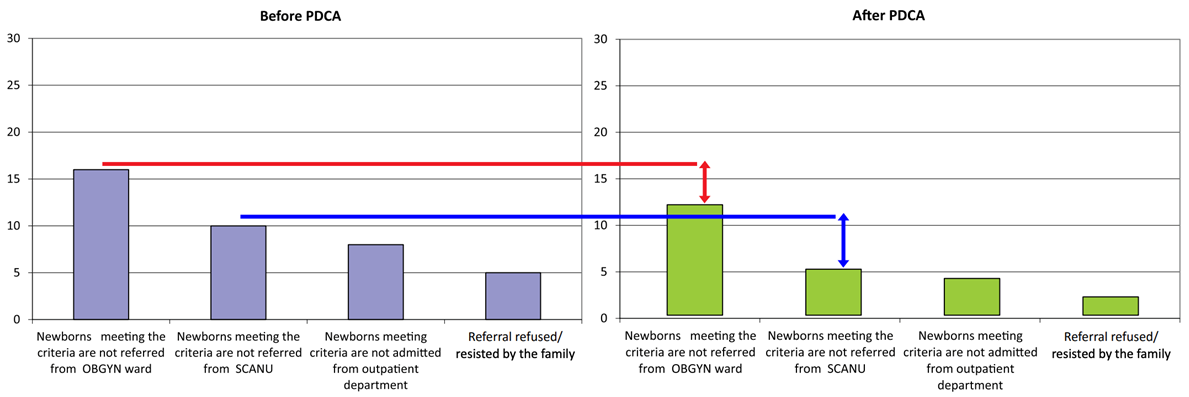
A Run Chart can be used to observe improvements over time. For example, the run chart (below) shows a decreasing trend in the number of patients who did not follow prescribed medication. This indicates the PDCA measures adopted by the hospital to address the issue have shown improvements over time.
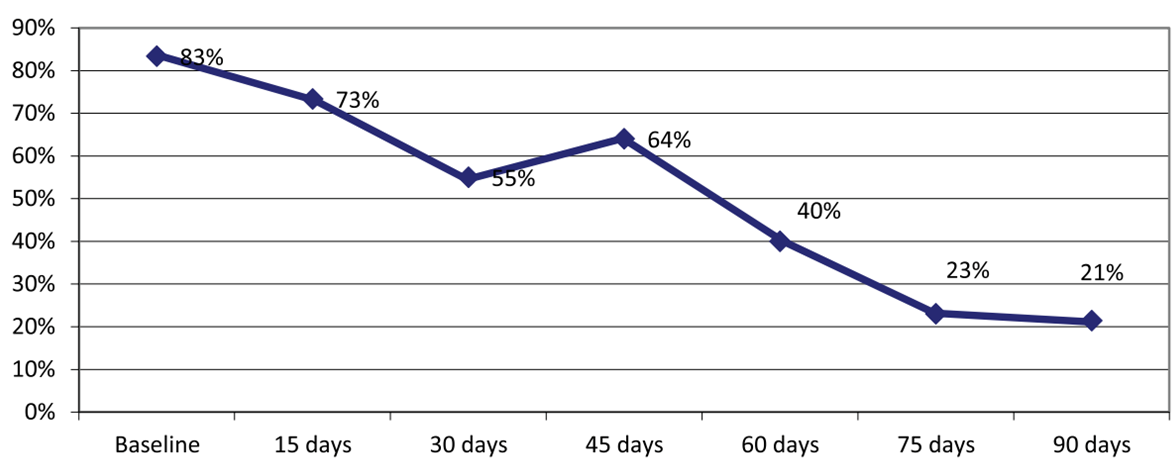
Step 7: Standardization of effective interventions
At this stage, the activities found to be effective in reducing or eliminating the problems are standardized using the following steps:
- List effective interventions identified in the previous step.
- Develop documentation (SOPs) to adopt successful intervention(s).
- Develop a checklist to assess the progress of implementing standardized activities.
- Share the plan and checklist with all concerned.
Standardization brings several benefits such as:
- Reduces variability.
- Ease in training new staff.
- Reduced chance of strain and injuries (ensures safety for internal/ external clients).
- Ease of following well-established practices reduces task time.
- Increases staff confidence & motivation.
Discipline is the key to successful standardization of an effective intervention.
PDCA at Toyota
No organization has ever come close to matching Toyota’s stellar performance in automobile manufacturing. It has cultivated a culture of excellence, efficiency, and customer satisfaction like no other.
PDCA at Toyota uses “Rapid Cycles,” where individual PDCA cycles are turned as quickly as possible, sometimes even taking only minutes each. The idea is to not wait for a perfect solution but to take the step at the earliest with available resources so that teams can spot the next challenge.
Toyota believes that a provisional step “now” is preferable to a perfect step “later”, and invests in prototypes and experiments up front, which may seem like an extra expense but has proven to reduce cost in the long run.
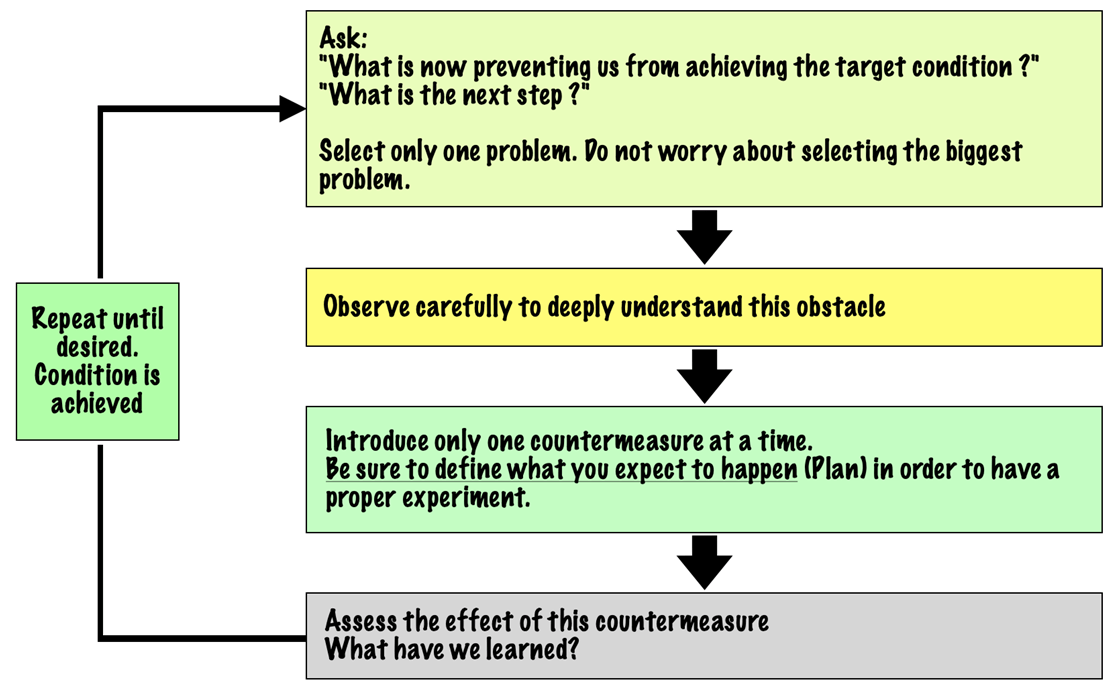
Toyota uses single-factor experiments, that is, to address one problem at a time and only change one thing at a time in a process. This helps see cause and effect and better understand the process.
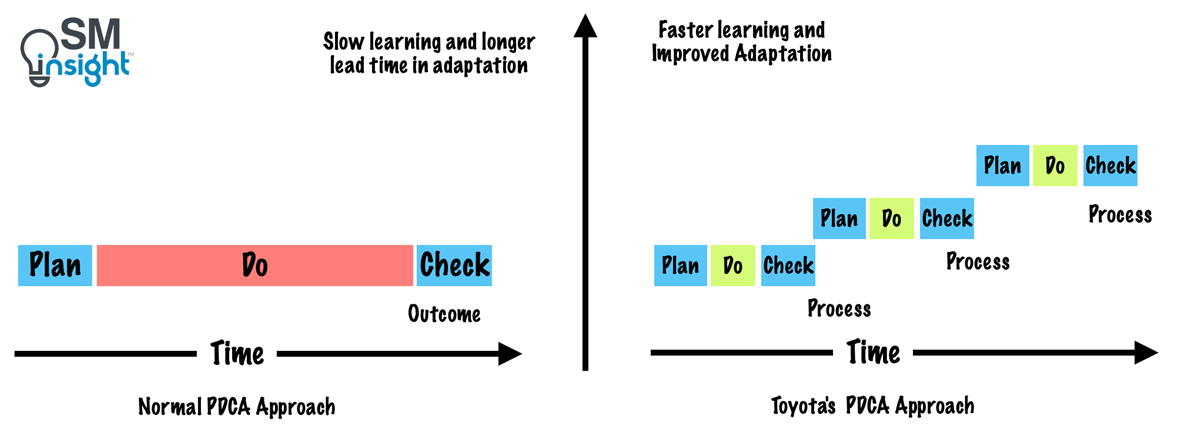
Toyota’s success is not due to sudden innovation or having air-tight plans but the ability to execute more effectively in the face of unforeseeable obstacles and difficulties. They spot problems at the process level much earlier when the problems are still small and address them quickly while uncovering information along the way.
Example of PDCA (the Toyota way)
Consider the process of getting up and going to work with a target condition of being in the car and ready to drive 60 minutes after waking up.
Here is one possible PDCA cycle for the process:
| Plan | Be in the car 60 minutes after waking up. (Target condition) |
| Do | Wake up and go through the morning routine, get into the car. |
| Check | Once in the car check how long it took. |
| Act | (Next step to be determined) |
Assume that with the above PDCA plan, a person sits in the car to find that the morning routine took 64 minutes, or four minutes over the target condition.
What has he learned about the process from this experiment?
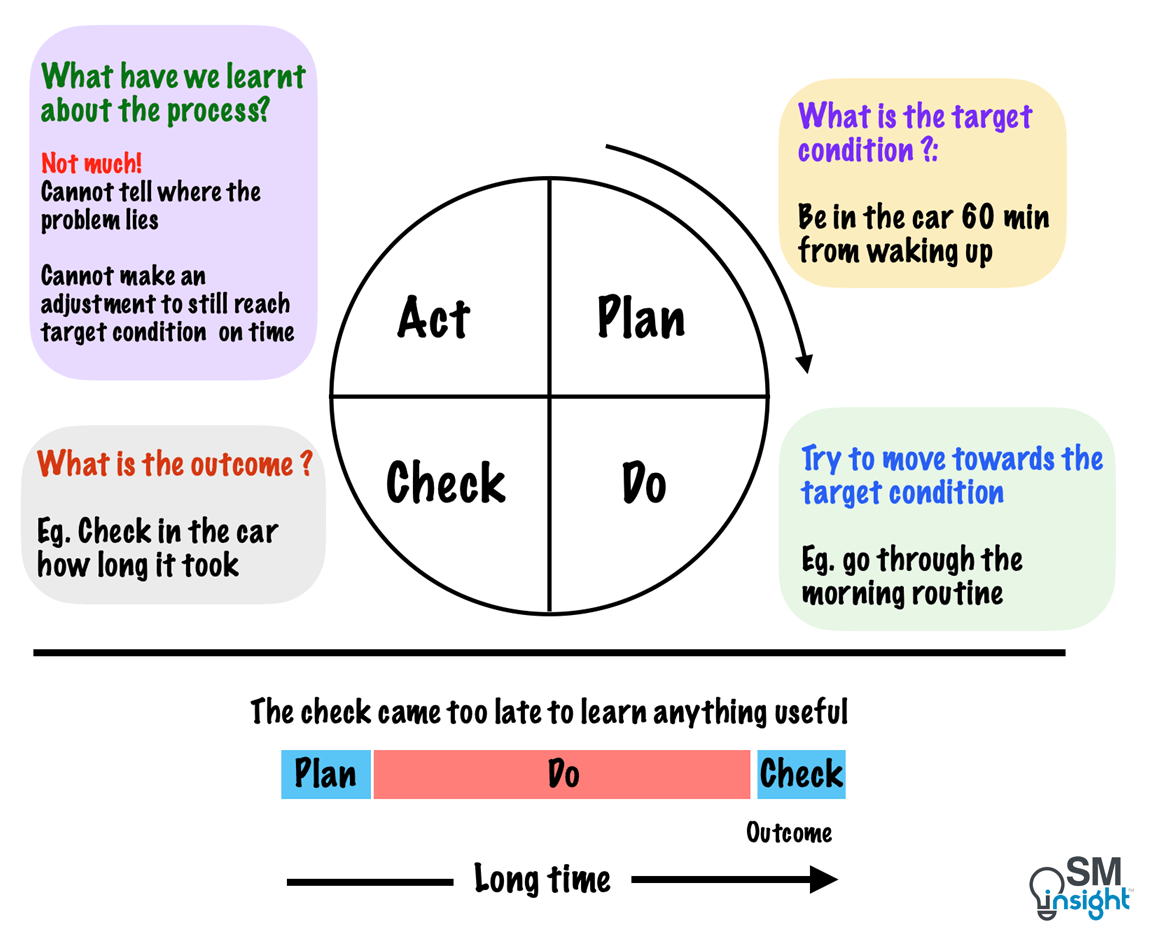
As depicted in the figure above, not much! The total time taken was over 60 minutes (too long), but it cannot be said where in the morning routine the problem lies. Also, it is too late to make an adjustment that would still achieve the target condition.
There are two things wrong with this PDCA experiment:
- The “check” comes too late to learn anything useful or to adjust on the way.
- The target condition specifies only an outcome. (it is not actually a target condition at all.)
Many seemingly large and sudden changes develop slowly. The problem is that organizations either fail to notice the little shifts taking place along the way or they do not take them seriously.
No problem is too small for a response. To be consciously adaptive, an organization must recognize abnormalities and changes as they arise and are still small and easy to grasp.
To be able to experiment in shorter cycles, a more detailed target condition is necessary. Such a target condition must generally include the following information:
- The steps of the process, their sequence, and their times
- Process characteristics
- Process metrics
- Outcome metrics
While a longer overall PDCA cycle must check the outcome, many short PDCA cycles must check process metrics along the way. Every step on the “staircase toward a target condition” is a PDCA cycle. Each step is a hypothesis, where what is learned from testing that hypothesis may influence the next step.
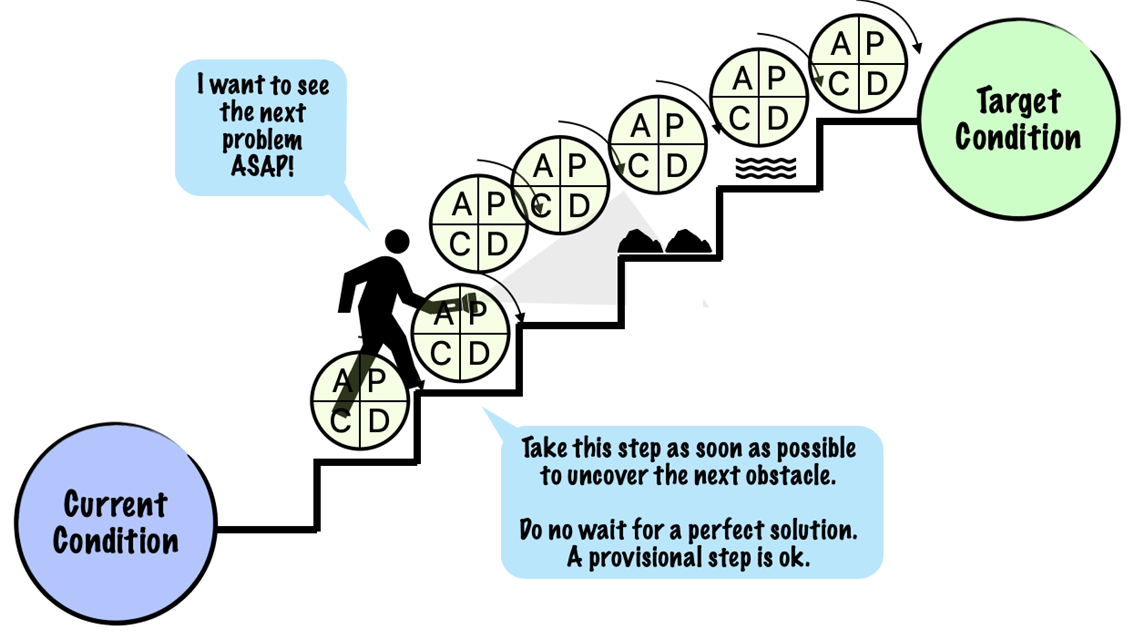
Accordingly, a modified and more effective experiment for the process of getting up and going to work, beginning with a better target condition, will look as follows:
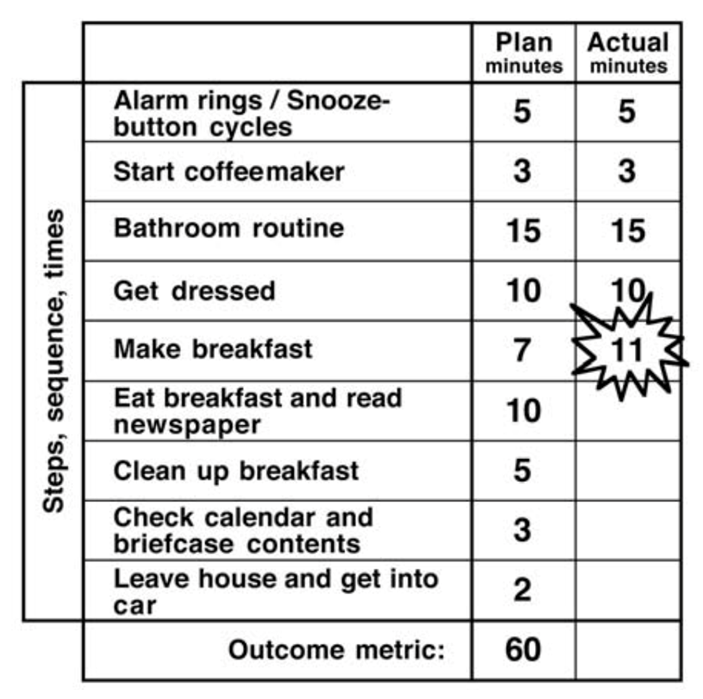
As seen from the figure, the step “Make breakfast” has taken four minutes longer than the planned time. From this, it is not only known where the problem is, but an adjustment can also be made to the remaining steps to still achieve the 60-minute outcome.
Questions critical to PDCA
PDCA phase of the improvement, after a target condition has been established, needs to answer the following five questions that are built on one another.
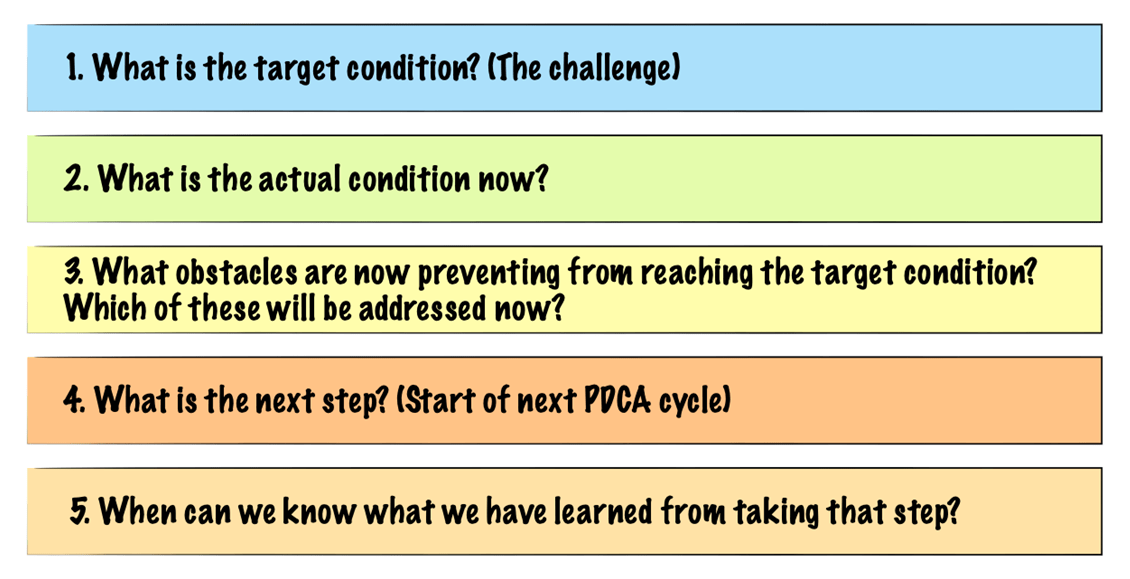
The sequence of these five questions acts as a device to give a routine and a mental pattern for approaching any process or situation. These questions distill part of the improvement down to a point where it becomes accessible and usable by anyone.
Sources
1. “The plan-do-check-act procedure”. Whale Design, https://www.shutterstock.com/image-vector/plandocheckact-procedure-deming-cycle-fourstep-model-2169522173 Accessed 22 Jul 2023
2. “Shewhart cycle”. Praxis Framework, https://www.praxisframework.org/en/library/shewhart-cycle Accessed 19 Jul 2023
3. “Walter A Shewhart”. Wikipedia, https://en.wikipedia.org/wiki/Walter_A._Shewhart Accessed 19 Jul 2023
4. “W. Edwards Deming Photo Gallery”. The Deming Institute, https://deming.org/w-edwards-deming-photo-gallery/ Accessed 19 Jul 2023
5. “Toyota Kata: Managing People for Improvement, Adaptiveness and Superior Results”. Mike Rother, https://www.amazon.com/Toyota-Kata-Managing-Improvement-Adaptiveness-ebook/dp/B002NPC0Q2https://www.amazon.com/Toyota-Kata-Managing-Improvement-Adaptiveness-ebook/dp/B002NPC0Q2 Accessed 19 Jul 2023
6. “WHAT IS A FLOWCHART?”. American Society for Quality, https://asq.org/quality-resources/flowchart Accessed 20 Jul 2023
7. “WHAT IS A DECISION MATRIX?”. American Society for Quality, https://asq.org/quality-resources/decision-matrix Accessed 20 Jul 2023
8. “FISHBONE DIAGRAM”. American Society for Quality, https://asq.org/quality-resources/fishbone Accessed 20 Jul 2023
9. “CHECK SHEET”. American Society for Quality, https://asq.org/quality-resources/check-sheet Accessed 20 Sep 2023
10. “WHAT IS A PARETO CHART?”. American Society for Quality, https://asq.org/quality-resources/pareto Accessed 20 Sep 2023
11. “WHAT IS STRATIFICATION?”. American Society for Quality, https://asq.org/quality-resources/stratification Accessed 20 Jul 2023
12. “Run Chart: Creation, Analysis, & Rules”. Six Sigma Study Guide, https://sixsigmastudyguide.com/run-chart/ Accessed 21 Jul 2023
13. “PDCA Manual for Quality Improvement”. Quality Improvement Secretariat (QIS), Health Economics Unit, Health Services Division, Ministry of Health and Family Welfare, http://qis.gov.bd/wp-content/uploads/2019/04/2019_02_07_1549518374_241pdca.pdf Accessed 21 Jul 2023

